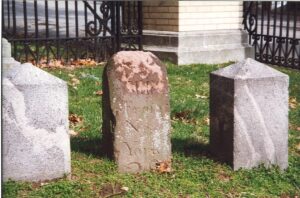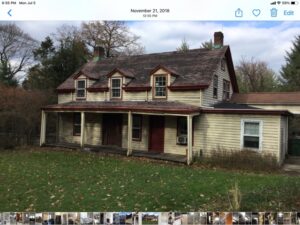
The Historical Society Serving Sleepy Hollow and Tarrytown has conferred landmark status on two 18th century sites: A milestone along the Albany Post Road in Sleepy Hollow and the home of a colonial tenant farmer in Tarrytown.
The sandstone milestone sits near the entrance to Sleepy Hollow Cemetery and the Old Dutch Church Burying Ground. It reads “Miles from New York 28.” This marker was seen by busy colonial farmers and merchants, George Washington and Revolutionary War soldiers, post riders and stagecoach drivers, and travelers hurrying to and from New York City. Today it stands as a unique Colonial era relic that anyone can visit.
Henry Steiner, Sleepy Hollow village historian, and Char Weigel of the Historical Society researched the history of many milestones along the Albany Post Road. “It is amazing that this stone survives,” said Steiner. “In the stretch from Dobbs Ferry to Ossining, only six of the original 12 remain and at least one of them is in a vulnerable location.” Weigel continued, ”While the stone is from the original series, it was likely moved from the 28-mile site a little down the road since it is now sitting at the 31-mile site. Clearly someone wanted to preserve it.” By awarding landmark status, The Historical Society hopes to bring awareness to both the historic significance of the milestone and the importance of its preservation.

The Society also awarded landmark status to the Acker-Forkill House, the home of a Colonial tenant farmer in southern Tarrytown. Stephen Acker (Ecker) served in the Westchester militia during the Revolutionary War. His farm appears in documentation as early as 1766 and was later purchased by Jon Forkill, reported to have been a Hessian deserter who settled in this area after the war. Washington Irving’s Sunnyside abutted Forkill’s property, and Forkill was Irving’s shoemaker. Forkill’s daughter Rachel Mann, who grew up in the house and inherited it from her father, was Irving’s shirtmaker. While away in Europe, Irving wrote about how much he missed visiting and chatting with “neighbor Forkill.”
The few Colonial-era structures still standing are generally homes of the wealthy or associated with Washington’s activities during the war. Little remains of the thousands who worked the farms of Philipsburg Manor or the hundreds who picked up their hunting guns to fight for independence. The Acker-Forkill House, long on the Historical Society’s list for landmarking, was almost lost to demolition in 2018. It was awarded Village of Tarrytown landmark status through a combined effort of the Historical Society, the Village of Tarrytown trustees and Planning Board, the Family Federation for World Peace and Unification at the Belvedere Family Community (owners at the time), other former owners and several concerned village residents.
Paul and Maria Birgy bought the house and are restoring the structure. “I am in awe of the workmanship of the hand-hewn beams, hand-made nails and quality of the 18th century builders,” observed Paul Birgy. “To think that Acker or others built this house without power tools and electricity… and that Washington Irving walked the floors when he visited Forkill.”
Birgy continued, “We feel a real connection to those who lived here before. It is fate that this house is still standing. Now it is our job to take care of it for future generations.” For over 250 years, the floors of this house rang with the footsteps of the Acker children, little Rachel Mann, and a long list of others soon to include the Birgy grandchildren.
The Historical Society has landmarked dozens of historically significant properties in Sleepy Hollow and Tarrytown. “It takes considerable research to support the Society’s landmark criteria,” said Sara Mascia, the society’s executive director. “We are excited to add these two new landmarks to our list, and to bring awareness of their importance in the ongoing history of our villages.”






